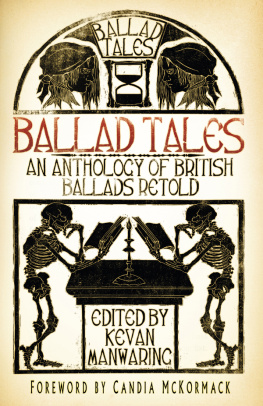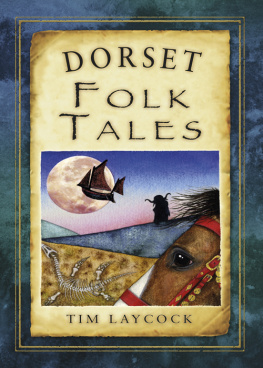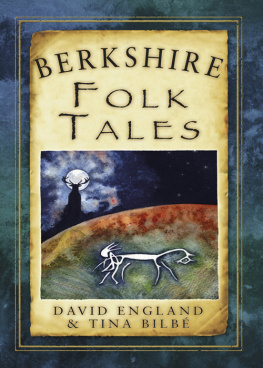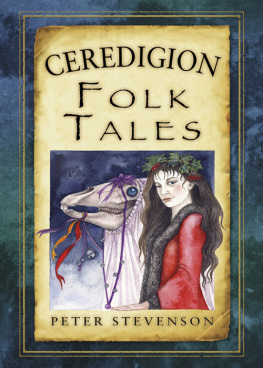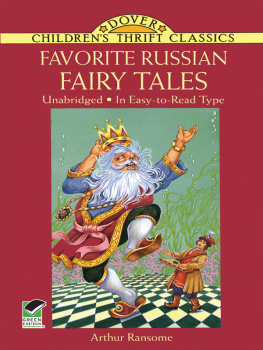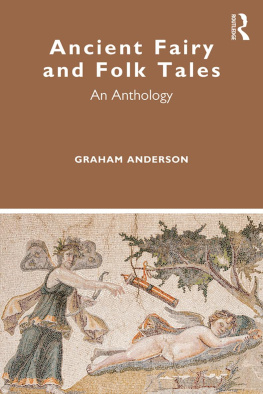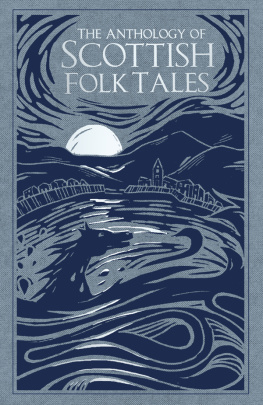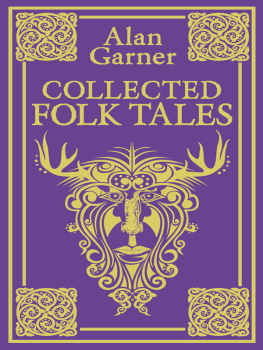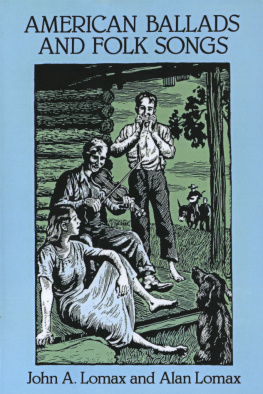BALLAD TALES
BALLAD TALES
AN ANTHOLOGY OF BRITISHBALLADS RETOLD
EDITED BY KEVAN MANWARING
FOREWORD BY CANDIA MCKORMACK

First published in 2017
Illustrations by Kevan Manwaring, 2017
Cover illustration by Andy Kinnear, 2017
The History Press
The Mill, Brimscombe Port
Stroud, Gloucestershire, GL5 2QG
www.thehistorypress.co.uk
This ebook edition first published in 2017
All rights reserved
Kevan Manwaring, 2017
The right of The Author to be identified as the Author of this work has been asserted in accordance with the Copyright, Designs and Patents Act 1988.
This ebook is copyright material and must not be copied, reproduced, transferred, distributed, leased, licensed or publicly performed or used in any way except as specifically permitted in writing by the publishers, as allowed under the terms and conditions under which it was purchased or as strictly permitted by applicable copyright law. Any unauthorised distribution or use of this text may be a direct infringement of the authors and publishers rights, and those responsible may be liable in law accordingly.
EPUB ISBN 978 0 7509 8319 8
Original typesetting by The History Press
eBook converted by Geethik Technologies

to dance
Contents
Acknowledgements
Thank you to all the singers, collectors and listeners of these ballads.
The Laidley Worm of Spindlestone Heugh by Malcolm Green was previously published in Northumberland Folk Tales (The History Press, 2014).
All illustrations by Kevan Manwaring.

Foreword
Selkies, storms, sorcery, seduction this is the language of the ballads that have been passed down to us from generation to generation.
The lilting rhythms of the poetry have woven their way into our psyches, enriching our appreciation of the land and giving a deeper understanding of our ancestors. There is magic all around us, of course, but it is often drowned out by the din of technology, hidden from view as we choose to watch our lives unfurl through the reflection of an ever-darkening black mirror.
There is a certain charm to the telling of tales, to the act of listening really listening and of retelling through song and speech, with the nuances that arise with each rendition. As music is recorded, uploaded, downloaded and shared, there is the temptation for others to create a faithful rendition tutorials provide musical notation, lyric sites make sure youre word-perfect, there are even computer games that reward you for how closely you adhere to the original! Really, though, the tribute band generation is taking its final bow and standing aside for a people who care about the art of storytelling, care about musicianship, and care about the joy of gently unravelling the cloth woven by storytellers before and creating something beautiful, entwining old threads with new. This cloth carries the fading colours of the old, while weaving in the bright-hued yarn of the new; ever changing, with respect for whats gone before while celebrating the excitement of whats yet to come.

And so it is with this collection of tales inspired by ballads of old; I do hope you enjoy reading them as much as I and, should you choose to retell any of them, please do remember to weave in your own bright thread.
Candia McKormack
Singer, Inkubus Sukkubus, 2017
Introduction
A collection of ballad tales might, on the surface, seem redundant the very term could be thought of as tautological. Surely a ballad, in essence a narrative-in-song, a folksong that tells a story, is a tale in itself and requires no further retelling? Well, there are indeed many fine ballads that can be listened to and enjoyed for their own sake a good cross-section are referenced in this anthology, and either before or after reading the respective prose retelling I recommend that you check out a selection of recordings from the archives and from modern musicians. You will perhaps be surprised by the number and diversity of the versions on offer with different lyrics, melodies, and arrangements none of which break the original, if indeed such a thing exists. There is rarely an urtext or master tape for a ballad even if we go by the oldest known recording, others may yet emerge. And you can guarantee that the version recorded at that precise point in time was just that a snapshot of an ongoing process, one with deep roots and ever-growing branches.
For a ballad to be traditional it is usually required to be anonymous and of perceived antiquity, although in actuality all ballads were written by somebody, somewhere, somewhen, and many were penned in the late nineteenth and twentieth century. Indeed, contemporary folk practitioners occasionally find their own song assimilated into the folk tradition and thought of as trad a category error considered an accolade by some. David Buchan, in The Ballad and the Folk (1972), offers one definition of a ballad as a narrative song created and re-created by traditional oral method, although he recognises the problems inherent in the notion of oral tradition and is careful to nuance his definition later into various subcategories (oral texts; oral-transitional texts; chap-transitional texts; chap texts; modern texts; and modern reproductions of these), even though he acknowledges Francis James Childs warning: Ballads are not like plants or insects, to be classified to a hairs breadth. Perhaps the best approach is a practical one. As Steve Roud, author of several books on folklore and folk music, including The New Penguin Book of English Folk Song (co-edited with Julia Bishop in 2012), quipped in a Folk Tale Symposium held in Stroud in September 2016, a folk song is a song sung by a folksinger.

I began researching folk songs, their collectors, and the nebulous processes of the oral tradition, as part of a Creative Writing PhD at the University of Leicester. The collection process can never be infallible or completely comprehensive (due to the collectors expectations, research ethics and social skills, their competency at transcribing lyrics or music accurately, the performers memory, and other mitigating factors the presence or absence of family members; work; illness; class; religion; ethnic and national prejudices). Something is always missed. For example, when Cecil Sharp and Maud Karpeles (leading figures in the folk-song revival of the early twentieth century) visited the tradition-bearer Jane Hicks Gentry in Hot Springs, North Carolina, in 1916, he and Maud diligently collected her amazing repertoire of love songs (as ballads were commonly called in the Appalachians) but completely missed her rattle-bag of Jack-Tales, which were simply not on their radar. It would take future collectors to acquire these.
Such blind spots within any specialist field are common, so it not surprising to see them occur in the folk music and storytelling scenes: folk festivals seldom book storytellers, and never give them prominent billing, however established they might be. Storytelling festivals are rarer and perhaps more keen to have the crowd-pulling power of established folk music acts; but storytelling clubs, although often open to musicians, generally dont encourage the democratic singarounds or sessions that you get in folk circles. And the two audiences, demographically almost indistinguishable, seldom mix. Although both undeniably part of the oral tradition, they seem at times to exist in separate universes, albeit with notable exceptions (e.g. Hugh Lupton and Chris Wood; Daniel Morderns troupe, The Devils Violin; British-Bulgarian performing arts group, A Spell in Time; or Richard Selby and Beth Porters collaborations in the Bath Folk Festival to name a few). This seems to me to be to their mutual impoverishment, because enthralling cross-fertilisation can occur, as Ive experienced in the group I co-founded, Fire Springs, and more recently with my partner, Chantelle Smith, in our ballads and tales duo, Brighids Flame.
Next page
